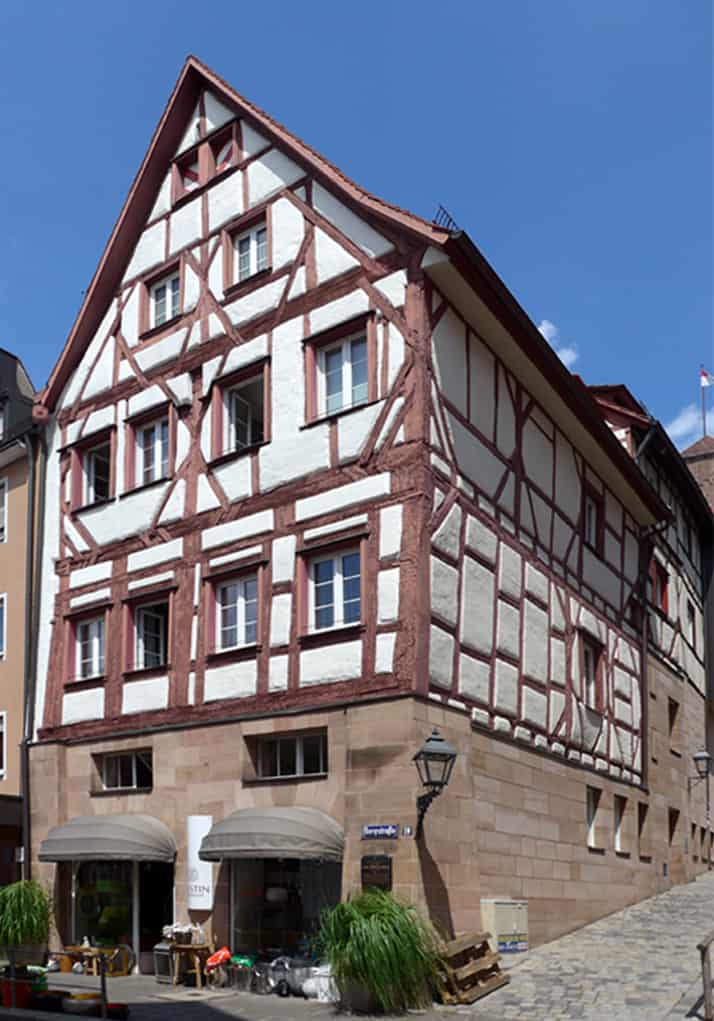PLACES OF REMEMBRANCE IN NUREMBERG
Maria Sibylla and Johann Andreas Graff lived in Nuremberg as a married couple for 14 years and their second daughter was born here in 1678. During this time Maria Sibylla, supported by her husband and Nuremberg civic society, developed her life-long interest: the observation of insects and their natural development.
In some places in Nuremberg this memory is still alive.
Living and Working in the House at the Milk Market
In 1668 Graff brought his young wife and their first baby daughter, Johanna Helena, from Frankfurt to his native town of Nuremberg. There, their second daughter, Dorothea Maria, was born in 1678 and they stayed there till 1682. Graff was from a family which enjoyed a good reputation; he was the son of a high-school headmaster and a poeta laureatus.
But where did they live? In the Church archives we find a note that Graff’s mother had died in 1649, in Nuremberg „at the Milk Market” (today Albrecht-Dürer-Platz with northern part of Bergstraße). (1) This is where her son Johann Andreas must have spent a large part of his childhood. He died in 1701, also “at the old Milk Market”. (2) Clearly, the house where the young Graff family moved in 1668 was owned by the family for many years. However, there are many houses on the Old Milk Market, and for centuries nobody knew which of them had been the Graff family dwelling.
Erich Mulzer, knowledgeable expert on Nuremberg history and for many years president of the “Altstadtfreunde” (Society of Friends of Nuremberg Old Town), with support from house historian, Karl Kohn, has verified the exact location of the Graffs’ residence through painstaking archival research (3): Before houses were numbered, the house was called “House to the Golden Sun”, because long before the Graffs bought it, it had been a pub.
The small lane to the east of this house “detached on the corner” was called “Sonnengäßlein” (Sun Lane) and linked “Obere Schmidgasse” (Upper Smith Lane) with “Oberer Milchmarkt” (Upper Milk Market).
The Graff Family Dwelling Bergstrasse 10
Commemorative Plaque at the Dwelling Bergstrasse 10
In autumn 2023 the city of Nuremberg had an additional QR code affixed to the lower left part of the plaque. At a modest 5 x 5 cm and gleaming like gold, the rectangle blends in harmoniously.
Photos: Dieter Lölhöffel
When at the end of Nuremberg’s time as an Imperial City, the houses in both halves of the city were numbered consecutively, this house was given the number “S[ebald] 443“. The front house was one of the few historic half-timbered houses in the Old Town which remained undamaged during World War II. Today’s address is: Bergstraße 10.
On the upper floors, the scarf joints (rather than mortise and tenon joints) in the timbers are clearly visible so that the timbering can be dated to pre-1520. Dendrochrono¬logical tests show that this house, including today’s upper floors was constructed in 1412. (5)
Only the stone ground floor has been altered, and on the first floor, the timbering was later replaced (mortise and tenon joints, i.e. after 1520), but the overall appearance has remained largely unchanged since the times of the Graff-Merianin family. It seems like a miracle that the house survived the almost complete destruction of this area in the Second World War.
The house can be easily found below the Imperial Castle, identifiable by its new commemorative plaque which was affixed in 2019.
In this spacious house, there was a lot of room for the couple’s activities:
- Maria Sibylla took great care of her caterpillars in wooden boxes behind the bull’s eye windows in the upper stories and supplied them with greenery from their special host plants, collected in the gardens and landscape around her house. She observed their metamorphoses, drawing them and writing notes on the changes.
- Johann Andreas took cityscapes; both of them painted and also had to carefully prepare their colours.
- They worked on copperplates for their etchings which might even have been printed on their own press in the house.
- Johann Andreas taught male pupils, and Maria Sibylla female pupils (6) to draw and to paint, perhaps also to create copperplate etchings, in addition Maria Sibylla also taught embroidery: “needle painting”.
In Nuremberg, it was not unusual for women, too, to teach, for there had long been writing and calculation instruction by female teachers for girls. Until the Reformation, it had been the custom for Patrician fathers to send their daughters to a convent for a period of tuition, without the girls having to join the convent as nuns. After the Reformation convents were no longer permitted to accept novices so this practice slowly died out. In Lutheran Nuremberg, idleness was considered a vice, and even girls in the upper strata of society had to learn something useful. Maria Sibylla’s “Jungfern Combannÿ” (Company of Maidens) (7) included girls from the Council families, such as Clara Regina Imhoff (8) as well as from the middle classes working in arts and crafts, such as a daughter of art dealer and publisher, Paul Fürst.(9).
The many windows of the house were not only advantageous for lighting the workshops: this is also where regularly insects were collected in their various stages of development and regularly provided with the respective branches, leaves, flowers and plants they fed on in nature. Optimum storage in boxes, their regular provision with suitable food, observation of their development, often for several months, and finally catching, killing and preparing the hatched insects was a complex and time-consuming task, and certainly both Maria Sibylla’s husband and her older daughter, and also the couple’s female (and male?) pupils must have lent a helping hand.
The new QR code is the first time the city of Nuremberg has combined the traditional design of a historical memorial plaque on a house façade with a modern source of information. At Bergstrasse 10, the entire Merianin website can now be opened in German and English via this QR code. People who like to use the worldwide web to orientate themselves on their city walks can now also surf the world of Merianin on the spot.
It is a lucky coincidence that the "purchase letter" with which Johann Andreas Graff’s widowed second wife sold the "Haus zur goldenen Sonne" has been preserved in a voluminous folio in the city archives. After more than 60 years in the possession of the Graff family, the "Haus zur Goldenen Sonne" got a "Notary and Arithmeticus" together with his wife (!) as new owners.
At a closer look, this house even begins to tell its own story: A recognized expert for historic townhouses in Nuremberg, Dipl.-Ing. Architect Michael Taschner, helps us with this, because he has allowed us to copy the section on Bergstrasse 10 from an already printed article (10) on our website.






